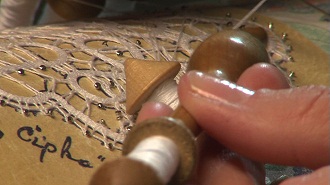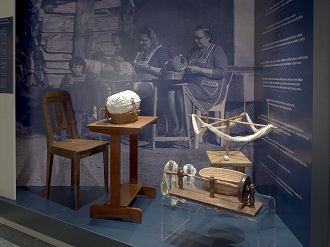 A town marked by mercury and lace
A town marked by mercury and lace
Idrija is a small town in Western Slovenia with a population of 6000, famous for its mercury mine, which is the second largest of its kind on the globe. The Idrija Mercury Mine operated for 500 years and, for Idrija, mercury represented a way of life. The origin of the town and its development are linked to the discovery of mercury; the development of health care, education and culture in Idrija are closely connected to mercury. Even lacemaking in Idrija, which dates back to the 17th century, owes its beginnings to mercury. And the mercury mine is closely linked to the establishment of our museum in 1953 - for the purpose of managing the town''s mining heritage. And finally, present-day Idrija is thriving and building its future on the heritage, knowledge and experience of many generations of miners.
The first lace exhibition was set up in our museum at Gewerkenegg Castle in Idrija in 1970. Over the years it gradually became outdated, and the desire to exhibit genuine Idrija lace began to take root when the Museum employed its first curator-ethnologist in the mid 1980''s, which brought aspirations for a new permanent exhibition. However, there was too much routine museum work and too many funding problems for any such idea to be realised at that time. Numerous occasional exhibitions nevertheless began to take shape in those years, which motivated people to begin searching at home for old lace pieces and articles of clothing adorned with lace, and instilled an awareness of the importance of the materials in their possession. Our efforts were focused on acquiring as many lace items as possible for our museum collection. We established contacts with other bobbin lacemaking centres, and began to present our lace products at occasional exhibitions beyond Slovenian borders. In 2002, we collected all our previous concepts for the new permanent exhibition and began to prepare conceptual guidelines for the exhibition and the architectural layout of rooms in the castle. A major share of the funds needed for the planning and execution of the project was contributed by the Municipality of Idrija, among others by financing the newly created job position of curator responsible for lace and lacemaking. The new permanent lace exhibition at Gewerkenegg Castle has united the story of the town and the mercury mine into an inseparable whole.
This was an enormous challenge for all those who participated in the project. How to place a modernly designed, multi-dimensional permanent exhibition with extremely complex materials in the historical setting of Gewerkenegg Castle? And how to present all that we wished to present:
• first of all, to place Idrija as a historically proven lacemaking centre on the European map of lacemaking centres;
• to prove the justifiability of using the name ra"Idrija lacela";
• to present the role of Idrija''s merchants in the development of lacemaking in the town;
• to present the significance of the Idrija lacemaking school in the past and present;
• to present the social situation of Idrija''s lacemakers;
• to present Idrija lace today - show how creativity can be combined with tradition;
• to contribute to the recognisability and preservation of intangible heritage of national importance.
Treasure chest of lace
The Idrija lace exhibition is the result of the collective work of experts in various fields. In the preparatory phase, the museum cooperated with numerous domestic and foreign cultural and scientific institutions and individuals, who assisted us with their knowledge and information in collecting materials and setting up the exhibition.
Our selection of designer and architect proved to be very wise, for these two experts demonstrated an exceptional feeling for exposing the main message of the exhibition, although this was their first encounter with Idrija lace. They knew how to make maximum use of the specific and complex layout of rooms in the castle. The main focus of the setup was to design the rooms in a manner enabling the most suitable presentation of such delicate and demanding materials as lace pieces. Some of the most difficult tasks included ensuring adequate illumination, the use of proper materials in showcases, and the sewing of lace items onto a textile base. The two main colours used in the exhibition, cinnabar red and silvery grey, are derived from elements of Idrija''s mercury heritage. Winding its way through the exhibition rooms is a patterned band carrying the most typical motifs of Idrija lace, and symbolizing the endless metres of lace exported from Idrija. The band also bears the inscriptions of individual thematic groups and serves as discrete scenery for ceiling lights. The exhibition begins in a room where we are introduced to the art of lacemaking, and ends with a treasure chest of the finest and most beautiful lace pieces.
The key factor for the exhibition''s success was our cooperation with lacemakers - the creators of lace pieces to whom our exhibition is dedicated. Their stories have been pulled out of anonymity and given the role that they deserve.
The exhibition is not caught in a certain historical moment, but continues to preserve the character of contemporaneity. Thanks to the possibility of updating exhibited items and presenting the annual events occurring at the Idrija Lace Festival in a film about festivals, the exhibition has remained topical. It is intended for a wide range of visitors. From those who primarily look for aesthetic pleasures to lace connoisseurs interested in the exhibition from the professional and research aspects.
 Endless white thread
Endless white thread
Looking back, it seems that the deficiencies encountered in the realisation of a project simply disappear or are difficult to confess after success is finally achieved. The experiences that we would certainly wish to avoid in future are mostly related to the uncertainties regarding the exact date of the exhibition opening (which was, of course, inseparably linked to the issue of funding) - this brought additional pressures to its creators. I should also mention the race with time as we neared the opening date, both as regards preparing leaflets, searching for final solutions for the setup of exhibits in showcases, and our worries and uncertainty about final results while waiting for subcontractors. Perhaps we could have chosen different design solutions, particularly as regards the glittery floor surface, which creates a multitude of reflections that are hard to suppress. We would also consider preparing an additional exhibition room for children, in which they could discover the skills of lacemaking.
To all those who will be embarking on a similar project, we recommend that you consider the advantages of multidisciplinary selection of authors (not necessarily within domestic institutions or environments), which undoubtedly contributes to the quality of a project because of the broad variety of ideas, the reconciling of different opinions and the consequent need to search for the best solutions, and the absence of apprehension due to unfamiliarity with individual professional fields, thus allowing for original approaches.
A successful project requires a clear vision, as well as the ability to improvise and adapt. In our case, one of our authors joined the project at a later stage because, as she was investigating archival materials in the course of the project, she arrived at new findings which partially changed both the appearance and content of the exhibition.
A very important component of every project is an appropriate time schedule in stages, which is, of course, always too ambitious, but rather than determining deadlines, its advantage is in recognising priority tasks.
And finally, a piece of advice in the area of finance: don''t forget to foresee an additional budget for the preparation of promotional materials, such as souvenirs, as it is highly possible that there will be no more additional funds available. In our case, promotional activities are extremely important because of our remoteness from major centres and poor traffic connections.
The professional excellence of our project is undoubtedly reflected in the successful cooperation of authors of different profiles within and outside the museum, which has by all means contributed to our greater expertise and given the exhibition a certain broadness, a new aesthetic dimension (owing to the specific nature of the main exhibited items - lace pieces, which our architect and designer, who were previously unfamiliar with lace, managed to present in a different way) and freshness. Despite its multiple authors, the exhibition began to develop a uniform and original image that is reflected in various layers:
- design solutions which managed to unite the high criteria for the protection of delicate lace textile material with the most effective setup;
- a smooth-flowing and interweaving story told in eight thematic groups;
- the ever-present, yet discreet symbolism of key attributes in bobbin lacemaking;
- aesthetic non-satiation according to the ra"less is morela" principle, which allows every exhibited lace item to find full expression.
Excellence is also reflected in the successful portrayal of the basic idea and message of the exhibition. More than the highest national professional recognition, the authors take pride in the fact that the most critical part of the public - Idrija''s lacemakers - have understood the message of their museum story and accepted it as their own.
We are currently preparing the first monograph on Idrija lace and an exhibition catalogue. The Museum is continuing the story of Idrija lace at occasional exhibitions. We are embarking on joint projects with various European partners, searching for similarities and differences, discovering links and cooperation, intercultural influences, and broadening our horizons.